 W
WAram, also known as Aramea, is the homeland of the Arameans and a region mentioned in the Bible in present-day Syria, including where the city of Aleppo now stands. At its height, Aram stretched from the Mount Lebanon range eastward across the Euphrates, including parts of the Khabur River valley in northwestern Mesopotamia on the border of Iraq. The region was known as The Land of the Amurru during the Akkadian Empire, Neo-Sumerian Empire and Old Assyrian Empire in reference to its largely Amorite inhabitants. During the Neo-Assyrian Empire, the Neo-Babylonian Empire and the Achaemenid Empire, Aram was known as Eber-Nari.
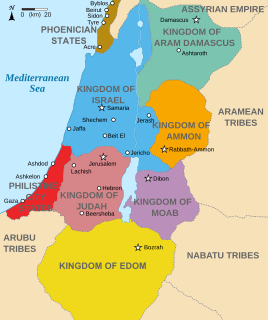 W
WAram-Damascus was an Aramean state around Damascus in Syria, from the late 12th century BC to 732 BC.
 W
WAram, also known as Aramea, is the homeland of the Arameans and a region mentioned in the Bible in present-day Syria, including where the city of Aleppo now stands. At its height, Aram stretched from the Mount Lebanon range eastward across the Euphrates, including parts of the Khabur River valley in northwestern Mesopotamia on the border of Iraq. The region was known as The Land of the Amurru during the Akkadian Empire, Neo-Sumerian Empire and Old Assyrian Empire in reference to its largely Amorite inhabitants. During the Neo-Assyrian Empire, the Neo-Babylonian Empire and the Achaemenid Empire, Aram was known as Eber-Nari.
 W
WArbāyistān or Beth Arabaye was a Sasanian province in Late Antiquity. Due to its situation and its road systems, the province was a source of income from commercial traffic, as well as a constant area of contention during the Roman-Persian wars.
 W
WAssyria, also called the Assyrian Empire, was a Mesopotamian kingdom and empire of the ancient Near East and the Levant that existed as a state from perhaps as early as the 25th century BC until its collapse between 612 BC and 609 BC – spanning the periods of the Early to Middle Bronze Age through to the late Iron Age. This vast span of time is divided into the Early Period, Old Assyrian Empire, Middle Assyrian Empire and Neo-Assyrian Empire.
 W
WThe Battle of Qarqar was fought in 853 BCE when the army of the Neo-Assyrian Empire led by Emperor Shalmaneser III encountered an allied army of eleven kings at Qarqar led by Hadadezer, called in Assyrian Adad-idir and possibly to be identified with King Benhadad II of Aram-Damascus, and Ahab, king of Israel. This battle, fought during the 854–846 BCE Assyrian conquest of Aram, is notable for having a larger number of combatants than any previous battle, and for being the first instance in which some peoples enter recorded history, such as the Arabs. The battle is recorded on the Kurkh Monoliths.
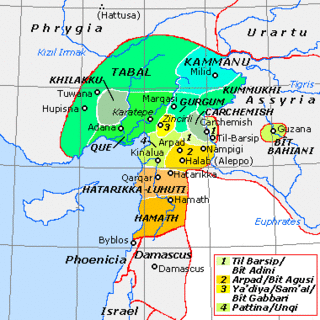 W
WBit Agusi or Bit Agushi was an ancient Aramaean Syro-Hittite state, established by Gusi of Yakhan at the beginning of the 9th century BC. It had included the cities of Arpad, Nampigi (Nampigu) and later on Aleppo. Arpad was the capital of the state-kingdom. Bit Agusi stretched from the A'zaz area in the north to Hamath in the south.
 W
WBit Baḫiani was an independent Aramean city-state kingdom with its capital at Guzana. Bit Baḫiani was ruled by King Kapara. There were at least five kings and four governors of Bit Baḫiani before losing its name in usage.
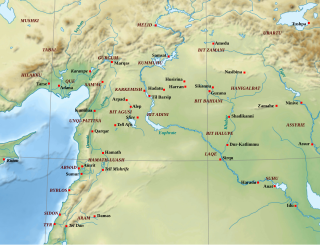 W
WBit-Ḫalupe, an ancient Aramean state in eastern Syria, located within the triangular area formed by the confluence of the Khabur River with the Euphrates River. It was one of the four Aramean states that bordered Assyria. The others were Bit-Zamani, Bit Bahiani and Laqe. By the ninth century BC all of them were assimilated by Assyria.
 W
WBit-Zamani, an ancient Aramean state in northern Mesopotamia, located within the mountainous region of Tur Abdin. In Bit-Zamani was the city of Amida. It was one of the four Aramean states that bordered Assyria. The others were Bit-Halupe, Bit Bahiani and Laqe. By the ninth century BC all of them lost to Assyria.
 W
WCanaan was a Semitic-speaking civilization and region in the Ancient Near East during the late 2nd millennium BC. The name "Canaan" appears throughout the Bible, where it corresponds to the Levant, in particular to the areas of the Southern Levant that provide the main setting of the narrative of the Bible: Phoenicia, Philistia, Israel, and other nations.
 W
WThe Early Period refers to the history of Assyrian civilization of Mesopotamia between 2500 BCE and 2025 BCE. It is the first of the four periods into which the history of the Assyrian civilisation is traditionally divided. The other periods are the Old Assyrian Empire, the Middle Assyrian Empire and the Neo-Assyrian Empire.
 W
WEber-Nari, also referred to as Transeuphratia by modern scholars, was a region of Western Asia and a satrapy of the Neo-Assyrian Empire, Neo-Babylonian Empire and Achaemenid Empire. The Akkadian Eber-Nari is referred to as Athura or Athuriya in Old Persian, and Aššur in the Elamite. The Targum Onkelos lists Nineveh, Calah, Reheboth, and Resen as being in the jurisdiction of Athura.
 W
WHilakku was one of the Neo-Hittite states during the Iron Age in southern Anatolia during the 1st millennium BC.
 W
WThe Hittites were an Anatolian people who played an important role in establishing an empire centered on Hattusa in north-central Anatolia around 1600 BC. This empire reached its height during the mid-14th century BC under Šuppiluliuma I, when it encompassed an area that included most of Anatolia as well as parts of the northern Levant and Upper Mesopotamia.
 W
WThe Hurrians were a people of the Bronze Age Near East. They spoke a Hurro-Urartian language called Hurrian and lived in Anatolia, Syria and Northern Mesopotamia. The largest and most influential Hurrian nation was the kingdom of Mitanni, its ruling class perhaps being Indo-Iranian speakers. The population of the Indo-European-speaking Hittite Empire in Anatolia included a large population of Hurrians, and there is significant Hurrian influence in Hittite mythology. By the Early Iron Age, the Hurrians had been assimilated with other peoples. Their remnants were subdued by a related people that formed the state of Urartu. The present-day Armenians are an amalgam of the Indo-European groups with the Hurrians and Urartians.
 W
WIturea is the Greek name of a Levantine region north of Galilee during the Late Hellenistic and early Roman periods. It extended from Mount Lebanon across the plain of Marsyas to the Anti-Lebanon mountains in Syria, with its centre in Chalcis.
 W
WThe King’s Highway was a trade route of vital importance in the ancient Near East, connecting Africa with Mesopotamia. It ran from Egypt across the Sinai Peninsula to Aqaba, then turned northward across Transjordan, to Damascus and the Euphrates River.
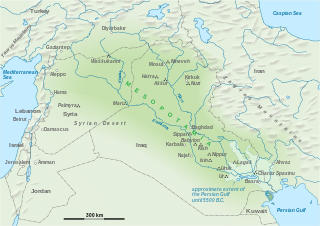 W
WMesopotamia is a historical region of Western Asia situated within the Tigris–Euphrates river system, in the northern part of the Fertile Crescent, in modern days roughly corresponding to most of Iraq, Kuwait, the eastern parts of Syria, Southeastern Turkey, and regions along the Turkish–Syrian and Iran–Iraq borders.
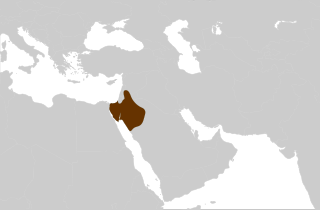 W
WThe Nabataean Kingdom, also named Nabatea, was a political state of the Arab Nabataeans during classical antiquity.
 W
WThe Nabataeans, also Nabateans, were an ancient Arab people who inhabited northern Arabia and the southern Levant. Their settlements—most prominently the assumed capital city of Raqmu —gave the name Nabatene to the Arabian borderland that stretched from the Euphrates to the Red Sea.
 W
WThe Namara inscription is a 4th century inscription in Arabic language, making it one of the earliest. It has also been interpreted as a late version of the Nabataean Arabic language in its transition to Arabic. It has been described by Irfan Shahid as "the most important Arabic inscription of pre-Islamic times" and by Kees Versteegh as "the most famous Arabic inscription". It is also an important source for the relationships between the Romans and the Arabs in that period.
 W
WThe Neo-Babylonian Empire, also known as the Second Babylonian Empire and historically known as the Chaldean Empire, was the last of the great Mesopotamian empires to be ruled by monarchs native to Mesopotamia. Beginning with Nabopolassar's coronation as King of Babylon in 626 BC and being firmly established through the fall of the Neo-Assyrian Empire in 612 BC, the Neo-Babylonian Empire would be short-lived, being conquered after less than a century by the Persian Achaemenid Empire in 539 BC.
 W
WThe Old Assyrian Empire is the second of four periods into which the history of Assyria is divided, the other three being the Early Assyrian Period, the Middle Assyrian Empire, and the Neo-Assyrian Empire. Assyria was a major Mesopotamian East Semitic-speaking kingdom and empire of the ancient Near East. Centered on the Tigris–Euphrates river system in Upper Mesopotamia, the Assyrian people came to rule powerful empires at several times. Making up a substantial part of the "cradle of civilization", which included Sumer, the Akkadian Empire, and Babylonia, Assyria was at the height of technological, scientific and cultural achievements at its peak.
 W
WPattin, was an ancient Luwian Syro-Hittite state at the beginning of the 1st millennium BC. It was known to the Assyrians as Unqi.
 W
WPhoenicia was an ancient Semitic-speaking thalassocratic civilization that originated in the Levant region of the eastern Mediterranean, primarily modern Lebanon. It was concentrated along the coast of Lebanon and included some coastal areas of modern Syria and Galilee, reaching as far north as Arwad and as far south as Acre and possibly Gaza. At its height between 1100 and 200 BC, Phoenician civilization spread across the Mediterranean, from the Levant to the Iberian Peninsula.
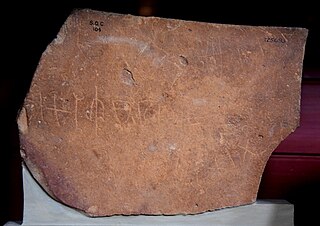 W
WSafaitic is a variety of the South Semitic script used by the nomads of the basalt desert of southern Syria and northern Jordan, the so-called Ḥarrah, to carve rock inscriptions in various dialects of Old Arabic and Ancient North Arabian. The Safaitic script is a member of the Ancient North Arabian (ANA) sub-grouping of the South Semitic script family, the genetic unity of which has yet to be demonstrated.
 W
WThe Sasanian Empire or Sassanid Empire, officially known as the Empire of Iranians, and called the Neo-Persian Empire by historians, was the last Persian imperial dynasty before the arrival of Islam in the mid seventh century AD. Named after the House of Sasan, it endured for over four centuries, from 224 to 651 AD, making it the longest-lived Persian dynasty. The Sasanian Empire succeeded the Parthian Empire, and reestablished the Iranians as a superpower in late antiquity, alongside its neighbouring arch-rival, the Roman-Byzantine Empire.
 W
WThe states that are called Neo-Hittite or, more recently, Syro-Hittite were Luwian-, Aramaic- and Phoenician-speaking political entities of the Iron Age in northern Syria and southern Anatolia that arose following the collapse of the Hittite Empire in around 1180 BC and lasted until roughly 700 BC. The term "Neo-Hittite" is sometimes reserved specifically for the Luwian-speaking principalities, like Milid and Carchemish. However, in a wider sense the broader cultural term "Syro-Hittite" is now applied to all the entities that arose in south-central Anatolia following the Hittite collapse, such as Tabal and Quwê, as well as those of northern and coastal Syria.
 W
WWife selling is the practice of a husband selling his wife and may include the sale of a female by a party outside a marriage. Wife selling has had numerous purposes throughout the practice's history; and the term "wife sale" is not defined in all sources relating to the topic.
 W
WYahu-Bihdi also called Ilu-Bihdi was a governor of Hamath appointed by the Assyrian government. He declared himself king of Hamath in 720 BC and led a revolt which was promptly suppressed. Yahu-Bihdi himself was flayed alive. His revolt occurred roughly shortly after the conquest of the Kingdom of Israel by Sargon II and roughly simultaneously with revolts in Babylon as well as in Arpad, Damascus and elsewhere in the Levant.
 W
WYamhad was an ancient Semitic kingdom centered on Ḥalab (Aleppo), Syria. The kingdom emerged at the end of the 19th century BC, and was ruled by the Yamhadite dynasty kings, who counted on both military and diplomacy to expand their realm. From the beginning of its establishment, the kingdom withstood the aggressions of its neighbors Mari, Qatna and Assyria, and was turned into the most powerful Syrian kingdom of its era through the actions of its king Yarim-Lim I. By the middle of the 18th century BC, most of Syria minus the south came under the authority of Yamhad, either as a direct possession or through vassalage, and for nearly a century and a half, Yamhad dominated northern, northwestern and eastern Syria, and had influence over small kingdoms in Mesopotamia at the borders of Elam. The kingdom was eventually destroyed by the Hittites, then annexed by Mitanni in the 16th century BC.
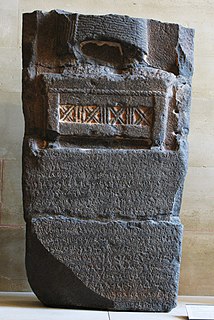 W
WZakkur was the ancient king of Hamath and Luhuti in Syria. He ruled around 785 BC. Most of the information about him comes from his basalt stele, known as the Stele of Zakkur.